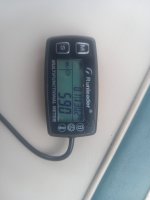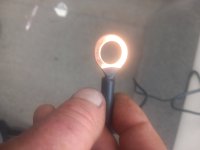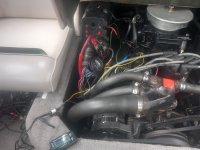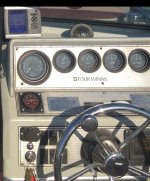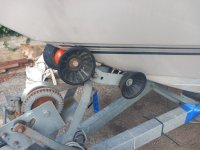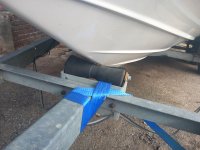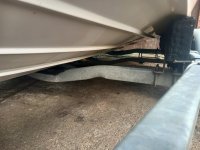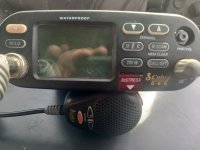The boat is still on the river around 30 miles from home, had two sessions on it today. Went around midday with the missus, did around 10 miles North on the river, turned around and back the 10 miles to the mooring. When we first got to the boat the trim worked and continued to work for around 10 minutes after starting the engine. When I went around 6pm with my son I hoped the trim would work again (maybe after the engine bay had cooled down) but it didn't. I'm still wondering if the trim problems could be heat related, is there a thermal cutout? I thought the red protrusion on the side of the trim solenoid (I think that's what it is attached to the pump assembly?) looked like a circuit breaker but when I went with my son I tried to press it and it didn't move. I suppose the engine bay would still be warm after the drive up river with the missus when I went with my son because it would only have had 2 hours to cool down. If the trim works next time I use the boat (when the engine bay is still cool) I'll be suspecting the problem is heat related even more.
Took a multimeter when I went with the missus but didn't use it when the trim seemed to work. It was getting late when I went with my son so still didn't use it. The only things I did to try to diagnose it were to try moving the trim power connection plug and try pressing the 'red button', neither of those things made any difference. I did check the ignition timing when I went with missus, seems set at 11BTDC which is very close to what I would have aimed for (its supposed to be 10BTDC but I'm running 97octane) so I left it as is.
There are quite a few wires enter the solenoid pack on the side of the pump but I think I'll be able to work out what wire does what, I expect the solenoid pack acts like the relays you mentioned and serves to send power to the pump motor with one polarity when the up button is pressed and opposite polarity when the down button is pressed... If that is true then if there is a problem with the solenoid pack I could replace it or even make a solenoid pack from relays.
I think you're on to something with debris in the thermostat. Today I ran the boat on the plane for a longer time than I did yesterday and the gauge stayed around 150 on the plane but went down to 125 at around 6knots. I have noticed the gauge go up slightly soon after slowing down after being on the plane but I kind of expected that. Not getting hot enough isn't good for the engine but it's much better than getting too hot. I'll have another look at the thermostat, I didn't put any sealant on the gasket so it should be easy to unbolt it and put it back together. Haven't seen any fluid leaks from the engine yet and the bilge is staying clean.
Took a multimeter when I went with the missus but didn't use it when the trim seemed to work. It was getting late when I went with my son so still didn't use it. The only things I did to try to diagnose it were to try moving the trim power connection plug and try pressing the 'red button', neither of those things made any difference. I did check the ignition timing when I went with missus, seems set at 11BTDC which is very close to what I would have aimed for (its supposed to be 10BTDC but I'm running 97octane) so I left it as is.
There are quite a few wires enter the solenoid pack on the side of the pump but I think I'll be able to work out what wire does what, I expect the solenoid pack acts like the relays you mentioned and serves to send power to the pump motor with one polarity when the up button is pressed and opposite polarity when the down button is pressed... If that is true then if there is a problem with the solenoid pack I could replace it or even make a solenoid pack from relays.
I think you're on to something with debris in the thermostat. Today I ran the boat on the plane for a longer time than I did yesterday and the gauge stayed around 150 on the plane but went down to 125 at around 6knots. I have noticed the gauge go up slightly soon after slowing down after being on the plane but I kind of expected that. Not getting hot enough isn't good for the engine but it's much better than getting too hot. I'll have another look at the thermostat, I didn't put any sealant on the gasket so it should be easy to unbolt it and put it back together. Haven't seen any fluid leaks from the engine yet and the bilge is staying clean.





















